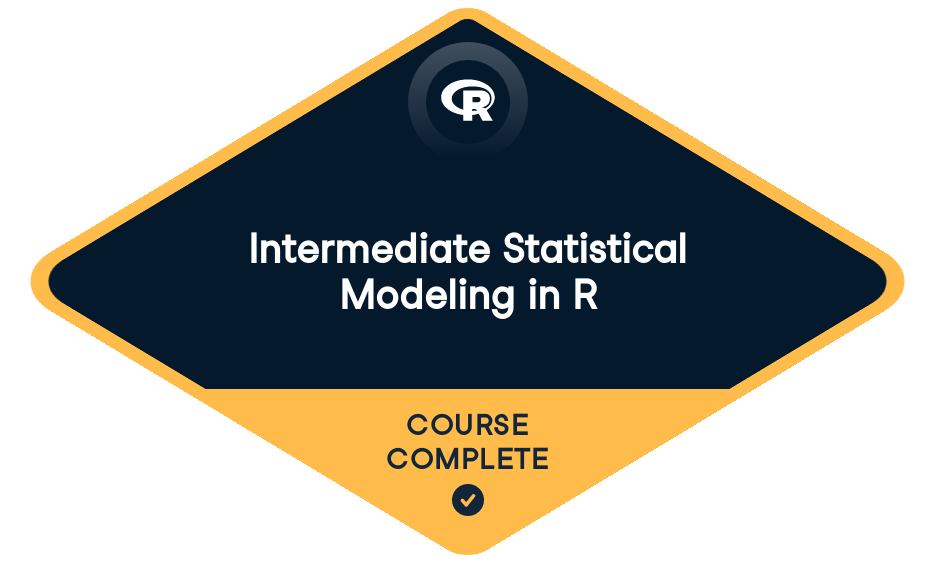Md. Saif Kabir Asif has completed
Intermediate Statistical Modeling in R
Start course For Free4 hours
3,300 XP

Loved by learners at thousands of companies
Course Description
Statistical Modeling in R is a multi-part course designed to get you up to speed with the most important and powerful methodologies in statistics. In this intermediate course 2, we'll take a look at effect size and interaction, the concepts of total and partial change, sampling variability and mathematical transforms, and the implications of something called collinearity. This course has been written from scratch, specifically for DataCamp users. As you'll see, by using computing and concepts from machine learning, we'll be able to leapfrog many of the marginal and esoteric topics encountered in traditional 'regression' courses.
For Business
Training 2 or more people?
Get your team access to the full DataCamp library, with centralized reporting, assignments, projects and more- 1
Effect size and interaction
FreeEffect sizes were introduced in Part 1 of this course series as a way to quantify how each explanatory variable is connected to the response. In this chapter, you'll meet some high-level tools that make it easier to calculate and visualize effect sizes. You'll see how to extend the notion of effect size to models with a categorical response variable. And you'll start to use interactions in constructing models to reflect the way that one explanatory variable can influence the effect size of another explanatory variable on the response.
Multiple explanatory variables50 xpGraphing a model of house prices100 xpBody-mass index (BMI)100 xpCategorical response variables50 xpEager runners50 xpWho are the mellow runners?100 xpSmoking and survival100 xpInteractions among explanatory variables50 xpWith and without an interaction term100 xpWorking together50 xpMileage and age interacting100 xpInteractions and effect size50 xpOptimal temperature50 xp - 2
Total and partial change
In many circumstances, an effect size tells you exactly what you need to know: how much the model output will change when one, and only one, explanatory variable changes. This is called partial change. In other situations, you will want to look at total change, which combines the effects of two or more explanatory variables. You'll also see an additional, but limited way of quantifying the extent to which the explanatory variables influence the response: R-squared. Finally, we'll describe the notion of degrees of freedom, a way of describing the complexity of a model.
Total and partial change50 xpAnother bedroom?100 xpCalculating total change100 xpCar prices100 xpR-squared50 xpCalculating R-squared100 xpWarming in Minneapolis?100 xpR-squared goes up100 xpDegrees of freedom50 xpRules for counting50 xpIs bigger R-squared better? (1)100 xpIs bigger R-squared better? (2)100 xpAccidental "perfection"100 xp - 3
Sampling variability and mathematical transforms
This chapter examines the precision with which a model can estimate an effect size. The lack of precision comes from sampling variability, which can be quantified using resampling and bootstrapping. You'll also see some ways to improve precision using mathematical transformations of variables.
Bootstrapping and precision50 xpA bootstrap trial100 xpFrom a bootstrap ensemble to the standard error100 xpExample: fireplaces100 xpScales and transformations50 xpTypical values of data100 xpExponential growth100 xpPrediction with log transforms100 xpConfidence intervals on log-transformed models100 xp - 4
Variables working together
In this final chapter, you'll learn about why you'd want to avoid collinearity, a common phenomenon in statistical modeling. You'll wrap up the course by discussing some of the ways models can be improved by involving the modeler in the design of the data collecting process.
For Business
Training 2 or more people?
Get your team access to the full DataCamp library, with centralized reporting, assignments, projects and moreDatasets
Used FordsCollaborators


Prerequisites
Introduction to Statistical Modeling in RDaniel Kaplan
See MoreDeWitt Wallace Professor at Macalester College
Join over 13 million learners and start Intermediate Statistical Modeling in R today!
Create Your Free Account
or
By continuing, you accept our Terms of Use, our Privacy Policy and that your data is stored in the USA.